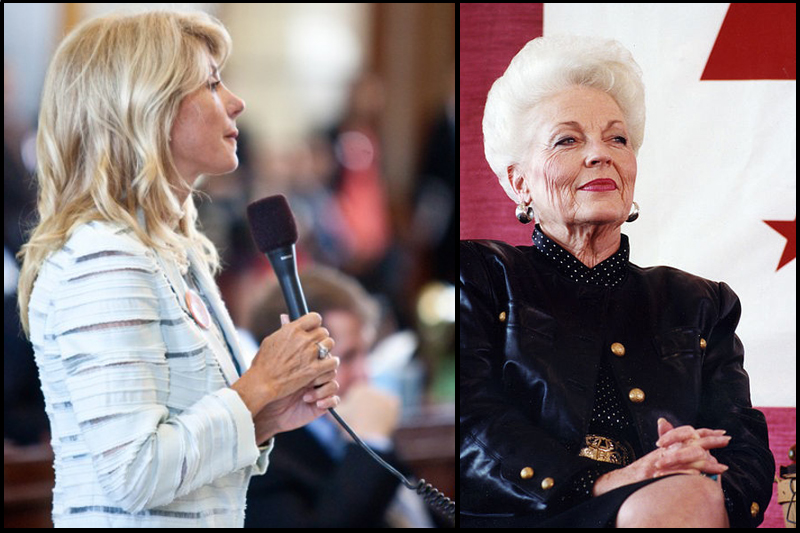
What Wendy Davis Can Learn from Ann Richards’ Gubernatorial Campaign

Above: Senator Wendy Davis (D-Fort Worth) and Governor Ann Richards.
Can Wendy Davis win the Texas governor’s race?
Is she a long-shot?
Are there lessons from Ann Richards’ 1990 upset victory over Republican Clayton
Williams that might help propel Wendy Davis into the governor’s mansion in 2014?
I think the answer to all three questions is “yes.”
As an old friend and veteran of Ann Richards’ political campaigns going back to her first election to the Travis County Commissioners Court in 1976, I see several similarities between Ann’s gubernatorial bid and Wendy Davis’.
When Ann Richards began her campaign for governor, she was an underdog, given little chance of winning by the pundits and political pros—even by some of the paid consultants on her own campaign staff. In the summer of 1990, after one of the most brutal Democratic primary elections in memory, Ann started her race against Clayton Williams more than 27 points behind him in the polls, considered to be an insurmountable obstacle to overcome.
Few people remember how bleak the situation looked for Ann as the campaign headed into Labor Day, just two months before the general election. The Capitol press corps had written her off and enjoyed taking pot-shots at her and her hapless campaign staff. After all, she was an underfunded, divorced single mother, a recovering alcoholic, a liberal Democrat, a civil rights activist and a pro-choice feminist in a conservative, increasingly Republican-leaning state.
Most political pros considered these facts so negative that it was a safe bet to predict her defeat, just as the “experts” are predicting defeat for Wendy Davis today. Yet, some of Ann’s closest friends and advisors were determined to do everything within their power to show the naysayers that there was a path to victory, no matter what the experts predicted. We knew we had to be bold, rather than cautious. So, we put on our blinders, ignored the carping and criticism, and forged ahead to create a disciplined and focused campaign that could be flexible enough to take advantage of any good luck that came our way. And we needed a lot of good luck!
We knew that Ann started out with a number of positive attributes. She had a proud record as an efficient, ethical and accomplished public official at the local and state levels. The same is true for Wendy.
Ann had a base of support among Texas women who had been inspired and encouraged to become involved in politics because of her election as Texas treasurer in 1982—the first woman elected statewide in 50 years. The same is true for Wendy because of her strong record on behalf of women as a state senator.
Ann had become a national celebrity because of her break-out keynote speech at the Democratic National Convention in 1988. Across the nation, thousands of Democrats wanted to help advance her career. The same is true for Wendy because of the national impact of her filibuster.
Ann had the capacity to be bold, take risks, and connect one-on-one with people on a personal level. The same is true for Wendy.
More important than any of this, however, was that we had learned a few important facts about Clayton Williams that we believed might tip the balance of the race in our direction. The same possibility exists for Wendy Davis. Her likely opponent, Greg Abbott, is not all that he appears to be and the real story about his tenure as attorney general could tip the race in her direction.
I think there are three broad lessons from the 1990 Richards campaign that might help Wendy Davis become the first Democrat to hold the governor’s office in 20 years.
The 1990 Richards campaign for governor was all about the numbers. We were guided by the wise campaign axiom: “If you can’t count it, don’t do it.” With the help of some very savvy veterans who had won earlier statewide campaigns, we developed specific numerical objectives for every major goal of the campaign, as well as a strategy to achieve them. First and foremost, we knew we had to get out the base Democratic vote. We quantified the exact numbers county by county, precinct by precinct.
The Wendy Davis campaign will obviously do the same. Although voter contact techniques, digital technology and statewide voting patterns have drastically changed in Texas since the 1990s, most effective political campaigns still focus on the number of favorable voters they are able to identify and turn out. There are some hopeful signs for Davis in the Texas numbers today.
The base Republican vote has peaked and is declining. The downward trends are evident in county-by-county voting analyses during the past two gubernatorial elections in non-presidential election years. On the other side, the base Democratic vote is growing organically, although it has rarely been extended effectively in recent elections. Both large and mid-size Texas cities are seeing extensive shifts in partisan voting patterns, primarily because of Hispanic population growth, but also because urban voters are bringing a more tolerant and progressive cultural mind-set to election contests. The challenge for the Davis campaign is to turn out this base Democratic vote, plus bring in an additional 20 percent of new Democratic voters.
The 1990 Richards campaign for governor was about suburban women. We developed relevant targeted messages and voter contact activities aimed at moderate suburban women. It paid off on election day.
The Wendy Davis campaign has the potential to do the same. Suburban women are turning away in droves from extremist Tea Party/Republican messages. According to a June 2013 Texas Tribune/University of Texas poll only 38 percent of suburban women currently identify themselves as Republican, compared to 50 percent in 2010. On the other side, self-identified Democratic women increased from 37 percent to 46 percent. The votes of suburban women are there for the taking with the right messages and organized voter-contact programs. These votes can shave margins from traditional Republican strongholds, increasing opportunities for a Davis victory.
The 1990 Richards campaign for governor was a referendum on Clayton Williams—his competence, his character, his business and his big mouth.
The decision to focus on Williams was a critical factor in Ann’s winning campaign and it may be the most important lesson for the Davis campaign in 2014. We made the campaign about Clayton Williams, rather than about Ann Richards. The Davis campaign can also force a referendum on the mean-spirited acts and opinions of Greg Abbott.
In the Richards campaign, we took the words and actions of Clayton Williams and used them against him. We were relentless in our attacks on his rape jokes, disrespect for women, ignorance of state government and unwillingness to reveal anything about his finances or tax records. Our campaign managed to throw him off balance and make him so angry that he refused to shake Ann’s hand at a public forum in Dallas in the presence of television cameras. This stupid act of bad behavior provided a new framework for voters to judge everything else he said or did. Finally after months of prodding by our campaign, Williams admitted that he had paid no income taxes for the previous few years, a decisive factor in his defeat. The focused efforts of our campaign forced Williams to make critical mistakes and we were well-organized enough to take advantage of them.
Greg Abbott’s record is ripe for similar disclosure. After holding statewide office for more than 20 years, he is still unknown and untested. He has already begun to make the kinds of gaffes that could torpedo his campaign. And even in red Texas, his ideas are out of touch on dozens of issues that matter to the majority of voters. He is against requiring employer-based health insurance policies to provide contraception coverage. He is against requiring background checks that prevent mentally ill people from buying guns. He is against providing adequate funding to improve the quality of Texas public schools. And he has done everything in his power to restrict the right to vote for ordinary people, particularly for those who are old or poor or who don’t have a driver’s license to show for identification. These are not left-right issues. They are issues that matter to suburban voters, as well as to the Democratic base.
No hotly contested political campaign in Texas is ever easy. Wendy Davis’s race may be one of the toughest in recent history.
She will have to be bold and stand her ground.
She will be brutally attacked on a personal and political level—just as Ann was.
She will be outspent—just as Ann was.
She will probably trail in the polls until the end of the campaign—just as Ann did.
But with a little good luck and her well-disciplined, numbers-based campaign that focuses on the record of Greg Abbott, Wendy Davis can pull off a major upset victory—just as Ann Richards did. She has the right mixture of courage, intelligence, and political savvy to make it happen.
Mary Beth Rogers ran Ann Richards 1990 campaign for governor, served as her chief of staff for two years, and later was the CEO of KLRU-TV in Austin. She now lives in Dallas.


